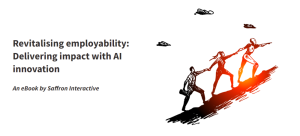e-Learning design is about serious stuff like transforming information into a format that really teaches people and helps them to retain it. Building effective interfaces and graphical representations for this purpose involves a good dose of dealing with content and data. But this doesn’t mean your design has to be dull and serious. The end learner wants to be engaged and so do you.
Deadly dull e-learning is more or less a thing of the past and now, more then ever, designers who work in this field are inclined to look for innovative ways to meet the changing objectives and expectations of clients and users. New technologies and fresh approaches mean our horizons are broadening in this branch of design and so I want to share some of what I have learned so far working in this growing world.
Define a hierarchy
It is crucial to create a sense of order and equilibrium in representing and communicating information. Without a clear visual hierarchy, different pieces of information fight for attention. Elements within an effective visual narrative should be arranged by order of importance, improving usability by grouping information into meaningful elements and sequences. A balanced architecture not only provides a clear way for recognising and understanding information, it also helps unify the different elements within a layout into an organic unity.
Make content king
You must create a design that serves its defined purpose and meets the defined scope, and that presents information in line with its objective. The most important task of e-learning design is to optimise the function, designing the user interface and visual elements to suit learner needs, and to maximise the learning experience. Using simplicity designers can clearly communicate ideas through the rational organisation of content and imagery. That’s why we have to organise the space instead of filling it out with fancy graphics and our aesthetic ego. The bottom line is that in e-learning we are focused on information design rather than on graphic design.
Remember, good design is innovative design
Technological developments keep offering new chances for innovative e-learning solutions. e-Learning designers have got now the opportunity to take advantage of fresh ways to manage and explore large and complex amounts of information and content. Although the devil in that is the risk of abusing of these brand new exciting tools just because they exist. What we need to do is take advantage of the right mature technology that is appropriate for each project’s scope and not just for the sake it. Again looking in-depth at the goals, needs, and contexts of the users remains the best approach.
Take an aesthetic view
Aesthetic quality in design always deals with details: subtle shades, harmony and the balance of a whole variety of visual elements. e-Learning design often applies this quality just to the containers and wrappers, leaving the individual visual elements free to float without the same level of quality. The challenge is to dress all the components with consistency, sacrificing maybe the variety for a standardised level of overall aesthetic quality. This doesn’t mean you have to pigeon hole your design, and remember that all good looking products work best when the functionality is consistent.
Add a little colour to the information
Confusion and clutter are the two main failures of e-learning design. Among the most powerful tools for reducing confusion and enriching the display is the technique of separation and stratification, visually layering various aspects of the content. In this, the use of colors is crucial. Colors can be the guide to drive the audience through a clear path for recognising and understanding information, and also help unify the disparate elements within a layout into a visual organisation. Accessibility is also particularly important in defining colours, considering that one in 12 people have some sort of color vision deficiency.
Make the logo smaller
e-Learning is maybe one among a few markets in which branding strategy is not so important. Usually companies ensure the impact and visibility of their brands are strong in order to increase sales and build customer loyalty. In e-learning, companies don’t need to advertise themselves in the same way. So while there are always brand guidelines to be considered, e-learning designers have a bit of freedom to make the logo smaller and the content bigger.





